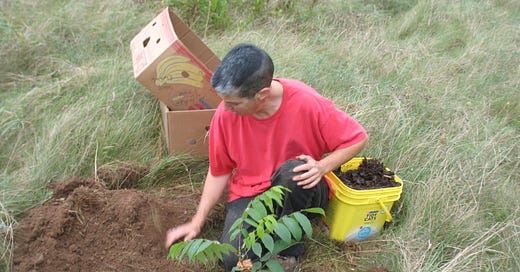I have been ‘officially’ forest gardening for the past eight years. However, I have been unofficially forest gardening the better part of my whole life - which is starting to be a long time!
Four years ago, when I first moved to our homestead farm in Cape Breton, Nova Scotia I started planting a forest garden. And when I say ‘first moved’ I really mean it! The U-haul, which contained all my worldly possessions - many of which were pots of trees and plants — wasn’t even unpacked and I was out in the field planting the black walnut saplings I had started from seed the previous spring. My newly planted trees —small in that vast treeless space — seemed insignificant tucked into their new surroundings. I knew though, that within a few short years they would begin taking-up space, emerging like living sculptures on the landscape. I loved imaging how, over the years to come, their tender spring leaf buds would herald the start of a new gardening season, reminding me of the delightful old folklore: ‘plant your corn seed when the leaf buds of the walnut tree are the size of a squirrels ear’s.


While the area of the field where I was planting my walnut trees was predominantly a mat of grass - the kinds of densely-rooted, wiry grass species that take over old pastures and hayfields in Nova Scotia —the rest of our field (approximately 6 acres in total) was already ‘growing-in’ with a diverse array of herbaceous flora - a scattering of perennial herbs, shrubs, and small trees. Intent on their own agenda of re-forestation, I expected these floral assemblages —sometimes called ‘pioneer species’ — to be comprised of the typical woody plant species that arrive (and thrive) after deforested land is given a few years reprieve from human interference. As if by magic, these herbaceous botanicals, seemingly, just ‘show-up’ to begin the task of re-cloaking denuded and degraded land. White spruce (Picea glauca), bayberry (Myrica pensylvanica), hawthorns (Crataegus spp.), serviceberries (Amelanchier spp.), and blueberry (Vaccinium augustifolium), intermingled with the goldenrods (Solidago spp.), St. John’s wort (Hypericum canadense) and common yarrow (Achillea millefolium)…. It really was a beautiful field — a garden by nature’s own design.

I have learned a lot about forest gardening by observing how thriving plant assemblages in nature tend to grow together. Rarely will you find a thriving stand of any kind of botanical growing in complete isolation from a diversity of other botanical species. And when you do find a single species community — like when a dense thicket of balsam fir (Abies balsamea) sprouts after a deforestation event, such as from clearcutting — many of those trees will quickly become straggly and die-out, presumably from competing for sunlight and soil nutrients.
According to soil microbiologist Dr. Christine Jones, botanical diversity is the key imperative to establishing resilient agricultural cropping systems - including field crops, pasture land, hayfields, and even orchards. It turns out that multi-species botanical assemblages actually build soil nutrients (and therefore soil itself) through processes of cooperation within the soil microbiome (“Secrets of the soil sociobiome with Dr. Christine Jones”). Much of this cooperation is courtesy of the fungal energy channel, that acts both like a neural pathway for information exchange, and supply-chain conduit between vascular plants (that capture sunlight and turn it into sugar/carbon), fungi, bacteria and other microscopic beings.
Over these past four years that I have wandered the back field and upper meadow of this old farmstead I have been continuously inspired by the multitude of unique forest garden guilds that have sprouted and grown, all on their own accord. I think of these as nature’s land-art installations, and I am grateful for the constant reminder that as humans we too are hardwired to appreciate an aesthetic that expresses diversity. If you don’t believe me, ask yourself this: which are you inclined to find more alluring — the panoramic floral complexity of a meadow, or the mono-cropping monotony of a corn or soybean field?

Over the next couple of posts I will explore the ways I have tried to emulate nature’s design principles, as I keep adding to the floral array of my black walnut guild.





This is so educational and beautiful to read. You make what seems like extremely complex knowledge accessible, and make me want to go out and plant a forest garden also!